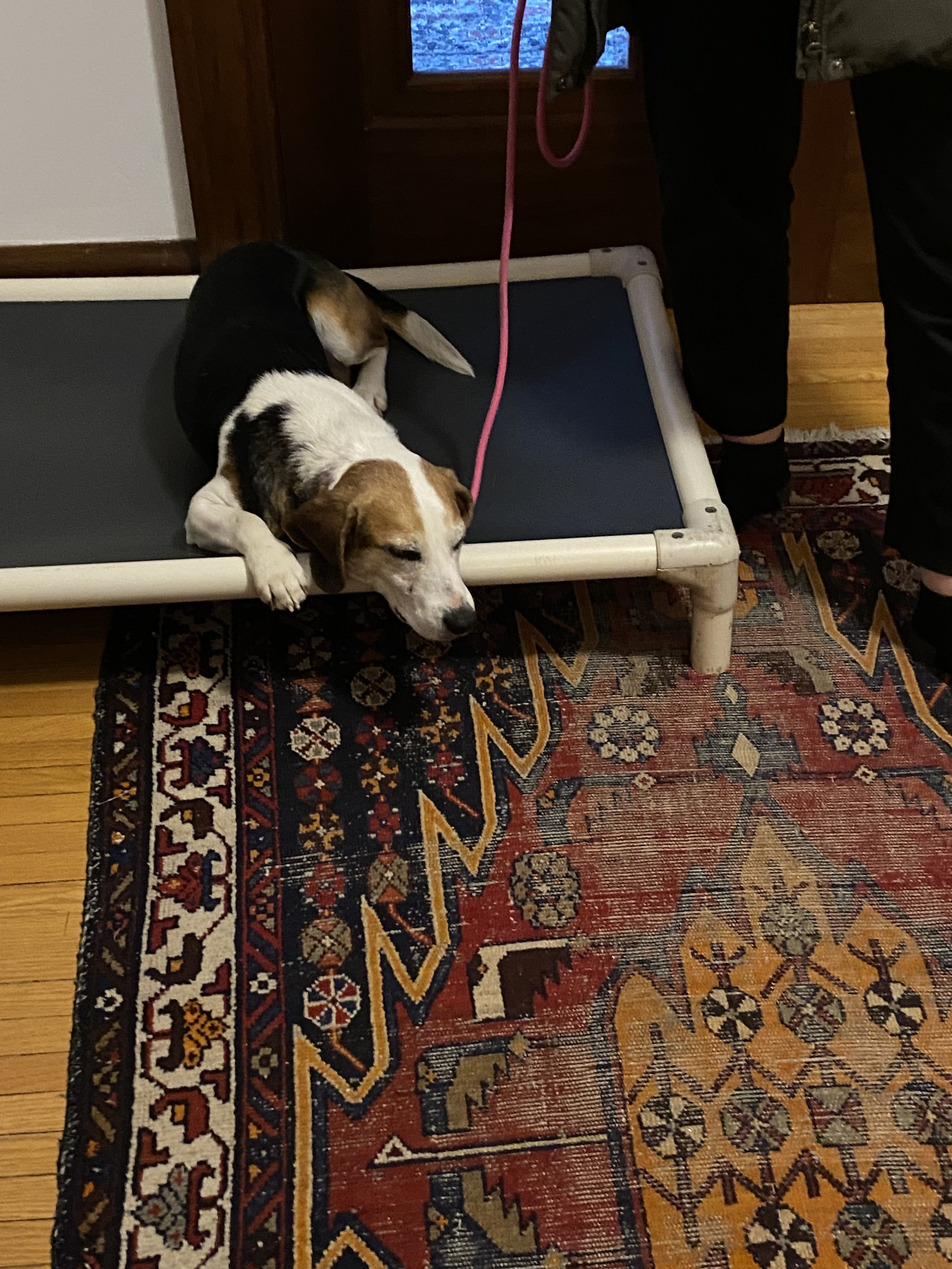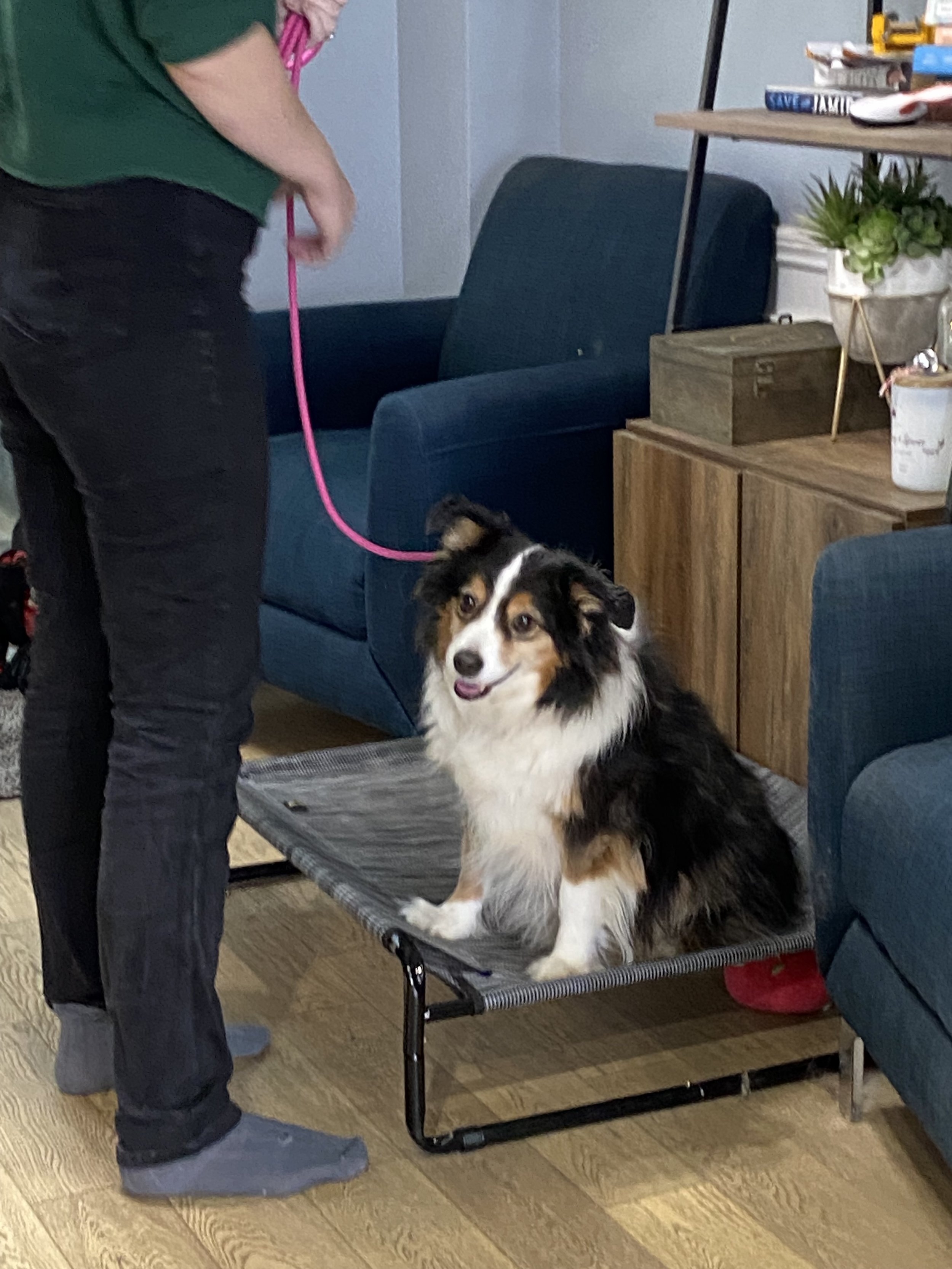A person sitting cross-legged to meditate. The photographer captured only her knee and her hand in Gyan Mudra
You’re worried that your dog can sense your anxiety. In fact, you can see him get more tense when you start wrapping the leash around and around your hand (which you always do when you see a dog…or a squirrel…or a jogger…actually, now it’s cars too. Eek!)
You’ve heard that stress travels down the leash and now you’re living it.
You can almost see the negative energy racing down the leash toward your dog like lightning and then BAM! - he blows up. He’s barking, lunging, and standing on his hind legs. This makes you feel embarrassed on top of anxious.
a large brown dog pulling on the leash
Your neck and shoulders constantly feel tight and your wrists hurt from holding her back when she lunges on the leash.
You feel like you’re caught in a stress hurricane with no end in sight.
How can you bring ease into your life with your dog when nothing feels easy.
The first thing I invite you to do is pause and breathe.
Set a timer on your phone for one minute. Sit down somewhere comfortable and close your eyes.
Breathe in for a count of four. Hold for two seconds. Breathe out for six seconds. When our exhale is longer than our inhale, it naturally calms us down.
One minute may be so enjoyable that next time you try 90 seconds. Make this a daily habit. The more you develop this calm muscle, the more you can call on it in times of stress (like after a reactive blow up.)
A person meditating on a yoga mat.
The next thing I invite you to do is to try the place command with your dog.
The place command is not only an amazing strategy to clearly communicate to your dog - go here, be calm, and stay until I release you, it’s also an opportunity for us to practice calm breathing while training our dog (instead of what’s currently going on during walks - a whole lotta breath-holding.)
Before you begin placework, you will need an elevated dog bed (place cot) with grippy feet. Be sure to set the cot on a non-slip surface before you introduce it to your dog.
Something amazing happens when we do placework with our dog. We begin to notice whether or not our dog can listen us in an area free from distraction - for example, inside your home. When we strip away all the things our dogs find distracting or stressful, we can begin to teach them how to be. All we’re asking for is calmness, and they respond with relief.
Phillip the foster dog sleeping on his place cot
Through this process, you become a detective, and uncover the reasons that your dog is so reactive on walks.
Maybe you’ll find out he’s afraid to step on the cot at all. He’s afraid of stepping up onto something and he isn’t trusting you to guide him through it yet. Don’t beat yourself up about this, this is just information your dog is sharing with you. You’ll get through it. But now you understand that if he can’t do what you ask inside your home, it makes sense that he won’t listen to you when he sees a dog, squirrel, or jogger coming at you on your walk.
Perhaps your dog has no problem hopping up onto the cot, but once he’s up there he jumps on you and bites the leash. This is very pushy and rude behaviour. This can tell us that our dog has become our boss, so he doesn’t think he needs to look to you for direction on the walk - he’s the boss of the walk.
Using placework as a diagnostic tool helps us reveal what we need to change in our relationship with our dog in order to improve it.
Sam the Golden Retriever laying down on her place cot. Her owner is holding her pink leash.
And something else amazing happens. We adopt a calmness practice as we practice place. Place isn’t just about your dog learning how to calm down - it’s an opportunity for us to learn calm skills as well.
While your dog is on place, you can practice breath work. You can practice being in the present moment. You can meditate. Did you know you can meditate standing up? You can!
As you work your dog on and off the cot, you can use this calmness that you’ve cultivated to improve your leash handling skills. If your dog gets off the cot and immediately pulls toward his favourite toy or another family member, it’s a reminder that if you allow him to do this inside your home, he will do the same thing on walks.
Before you know it, you have created a ritual that calms you and your dog down. You can use this routine before your walks to make sure you’re both present and connected before you leave home.
Lily the Australian Shepherd sitting on her place cot in her home.
Take your time and enjoy developing these newfound calmness skills.
The more you practice, the better you’ll both feel.
Before you know it you’ll be able to put your dog on place and:
-sit on your couch and meditate (or read a book)
-practice yoga without being stepped on, mouthed, or mounted
-have a friend over for a chat
-turn your dining room table into a place for painting, crafting, or puzzles
With your dog on place, she’s no longer:
-anxiously barking at your visitors
-jumping all over you, your family, and your guests
-racing from window to window barking at every sound she hears
-panting, pacing, and nervous
-bolting out the front door and running away
-stealing food off the countertop
With those worries gone from your list, you can be free to be a calmer version of yourself. A more peaceful version of yourself.
If you’re nervous about trying placework on your own, in-home sessions will quickly help you build your confidence.
With weekly sessions, homework that you and your dog will actually enjoy doing together, and email support to keep you on track, you’ll feel like you have a trainer on speed dial.
Schedule your free call now. You deserve more calmness in your life.
Yours in calmness,
Alyssa
Photos by: a person sitting cross-legged to meditate. The photographer captured only her knee and her hand in Gyan Mudra Ksenia Makagonova @dearseymour; a large brown dog pulling on the leash (Upsplash Images); person meditating on a yoga mat (Katerina May @kat_vagary); Phillip the foster dog sleeping on his place cot (Alyssa Foulkes); Sam the Golden Retriever laying down on her place cot (Alyssa Foulkes); Lily the Australian Shepherd sitting on her place cot (Alyssa Foulkes)






